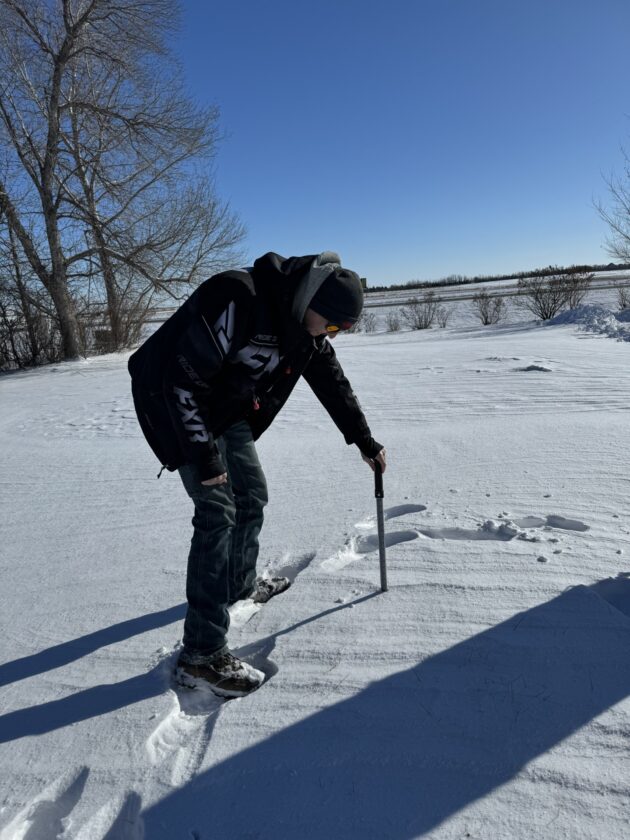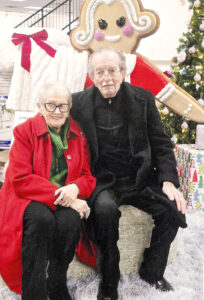Keeping weather data updated
Weather recorder provides up-to-date readings in area

While checking the depth of fresh snowfall on Monday, Austin Kraklau says, “It's a good day to live in North Dakota.”
For the past five years, Austin Kraklau has been working for the North Dakota State University’s North Central Research Extension Center, south of Minot. He records the weather and sends the readings to the National Weather Service in Bismarck.
Originally, Kraklau is from Minnesota. He came to North Dakota for college, enrolling as an engineering major at NDSU in Fargo. Two semesters passed before he figured out that was not the career path for him. One day, he was talking to one of his friends whose major was agricultural systems management, and he thought that sounded a lot better than his original plan.
He switched his major and completed his bachelor’s degree in five years. Upon graduation, he noticed North Central Research Extension Center had a research specialist position open, so he applied.
He spent two years as a research specialist before Joe Effertz left the office. With his departure, someone needed to fill the desk and that someone turned out to be Kraklau. Despite not having much of an option in the matter, he said he enjoys what he does.
Each morning as part of his job at the research center, he checks the equipment that sits outside his office and measures the temperature, precipitation and moisture levels, wind speed and ground frost depth. Kraklau said he typically spends about 10 minutes outside every morning, checking all of his equipment and gathering his readings to send to the NWS office in Bismarck.

Austin Kraklau collects a snow core sample with the tube from the precipitation gauge on Monday after Sunday's snowfall.
In front of the agronomy research center, a metal can is left on a stand inside of a ring, which is covered in triangle-shaped pieces of metal that hang from the ring. The can is used to collect moisture to determine how much fell. The triangles were once used to tell which direction the wind was blowing before technology at the airport took over.
The precipitation gauge was described as being “awkward” and “spaceship-shaped” by Kraklau. Precipitation falls into a container that sits on a scale inside the device. This allows the National Weather Service to see exactly what time precipitation falls.
Off to the side of the building is the thermometer, which looks like a small lantern on a 6-foot pole, and it sends the temperature to a black box in Kraklau’s office, where he writes down the times it changes to find the high and low for the day.
During the winter months when things slow down a bit, Kraklau said he helps where he can. The greenhouse contains the seeds the center plants in its research on which pesticides and herbicides work on which plants. Equipment occasionally breaks, so having the extra time on his hands gives him a chance to help work on things to get them back into running order more quickly.
Instead of measuring rainfall levels, he uses a designated stick to measure snow. His usual testing ground is the parking lot, as it is flat and cleared regularly, which makes it much easier and more accurate for fresh snowfall.

Ciara Parizek/MDN Austin Kraklau from the North Dakota State University Research Extension Center takes the snow core tube to the lab to find out how much snow fell.
The stick looks like a ruler, but the intervals are all measured in tenths.
If the parking lot is not cleared before a storm, a snow core must be collected in the long metal can, melted down in the lab, then measured to get an estimate of how much moisture is sitting on the ground in the form of snow.
Every time there is new snowfall, he must go outside and take a new snow core sample, then repeat the measuring process.
He also uses a frost gauge, a plastic tube with water in it that is inserted into a pipe in the ground. The water freezes in the tube to show how deep the frost goes. The two easiest ways to check are to inspect the water to see where the freezing stopped, or to snap the ice inside the tube until the end is found.
According to Kraklau, the snow core collection and frost readings help the NWS predict what flood dangers could result from the snowmelt.
The Minot International Airport has an automatic weather observation service (AWOS) that measures the wind direction and speed in knots, the statute of visibility (how far a person can see), cloud coverage, temperature and dew point in Celsius and barometric pressure in inches of mercury. It automatically records all of the information every five minutes.
Kraklau’s job is more involved than that, having to spend time outside, recording things by hand and sending it off. By taking the extra time to go outside and physically collect samples, Kraklau ensures the numbers the NWS gives to the public are accurate and up-to-date.
February temp higher than long-term average
This past month of February, the average temperature was 25.4 degrees, which was 13.3 degrees warmer than the 117-year long-term average of 12.1 degrees, according to Austin Kraklau of the North Central Research Extension Center, south of Minot.
Kraklau said the lowest temperature of the month was -6 degrees on Feb. 16 and the high was 53 degrees on Feb. 27.
The total moisture for the month was 0.49 inches, which is 0.01 inches below the long-term average of 0.50 inches.
The total snow for the month was 2.7 inches, which is 3 inches below the long-term average of 5.7 inches, Kraklau said.
- While checking the depth of fresh snowfall on Monday, Austin Kraklau says, “It’s a good day to live in North Dakota.”
- Austin Kraklau collects a snow core sample with the tube from the precipitation gauge on Monday after Sunday’s snowfall.
- Ciara Parizek/MDN Austin Kraklau from the North Dakota State University Research Extension Center takes the snow core tube to the lab to find out how much snow fell.





